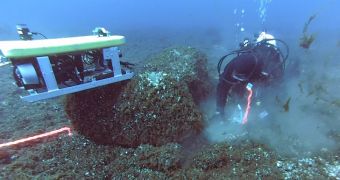A recent paper in the journal Proceedings of the National Academy of Sciences details the discovery of an ancient caribou hunting site under Lake Huron, one of North America's five Great Lakes. The site is estimated to be about 9,000 years old and currently sits under about 121 feet (37 meters) of water.
Information shared with the public says that the site comprises an array of linear stone lanes and several V-shaped structures. Archaeologists have reasons to believe that ancient people used the lanes and the structures to corral caribou and thus ensure that the hunt was going to be a successful one.
In their paper in the journal Proceedings of the National Academy of Sciences, the underwater archaeologists who discovered this ancient hunting site explain that, thousands of years ago, the region that accommodates for it was an exposed land corridor.
Evidence indicates that caribou herds used to migrate across this land corridor, which connects northeast Michigan to southern Ontario, on a regular basis. Ancient people must have been aware of this, hence their decision to create the recently discovered hunting structure.
With the help of a remotely operated vehicle and an underwater sonar, researchers have managed to pin down two parallel lines made of stones that make up a northwesterly oriented lane measuring about 26 feet (8 meters) in width and 96 feet (30 meters) in length. The lane leads to a natural dead end.
V-shaped hunting blinds which face the southeast and an area where meat was likely stored have also been documented in the proximity of this lane. All in all, the hunting site covers a region spanning over roughly 92 feet by 330 feet (28 meters by100 meters), archaeologists say.
Given the fact that chipped stone debris that served to repair stone tools has also been found in and around this hunting site, there is little doubt that ancient people purposely built the lane and its accompanying structures and used it to hunt caribou.
Researchers expect that, by studying this hunting site under Lake Huron, they will be able to gain a better understanding of how people who lived 9,000 years ago interacted with one another and relied on each other to hunt during certain times of the year.
“This site and its associated artifacts, along with environmental and simulation studies, suggest that Late Paleoindian/Early Archaic caribou hunters employed distinctly different seasonal approaches. In autumn, small groups carried out the caribou hunts, and in spring, larger groups of hunters cooperated,” said specialist John O'Shea with the University of Michigan.
“The larger size and multiple parts of the complex drive lanes would have necessitated a larger cooperating group of individuals involved in the hunt. The smaller V-shaped hunting blinds could be operated by very small family groups relying on the natural shape of the landform to channel caribou towards them,” he added.

 14 DAY TRIAL //
14 DAY TRIAL //